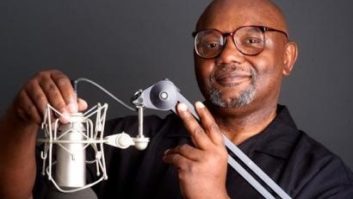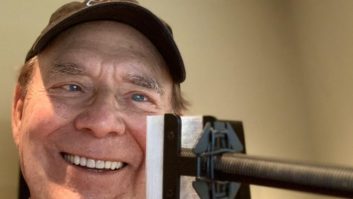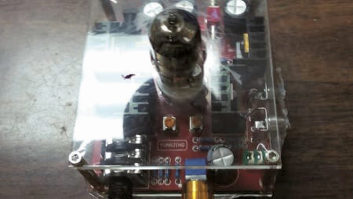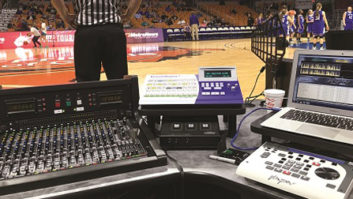(click thumbnail)Sennheiser MD 46 dynamic microphoneThose of us who make audio recordings in the field work in an unforgiving world of noise.
Sometimes the sounds we want to record are hidden amongst the noise. It takes a sensitive instrument to find and bring those sounds to the forefront. That is what the Sennheiser MD 46 dynamic microphone does.
Mic at the Olympics
The MD 46 is a unidirectional dynamic microphone. Viewers of NBC TV coverage of the 2000 Sydney Olympics saw these mics with an NBC Olympic microphone flag.
Anthony Buzzeo, Sennheiser USA assistant product manager for microphones and specialty products, said the MD 46 went from a clean screen to full production in a year.
“Bob Dixon of NBC Olympics told (Sennheiser executives) Rolf Meyer and Scott Schumer that the network was interested in a Sennheiser cardioid interview microphone and that he would buy 170 mics for the Sydney Summer Olympics if they could develop one quickly.”
No problem plosives
The tendency for a unidirectional mic to emphasize plosives convinces some people not to use them in the field. I used the MD 46 to record news makers at an upstate New York winery for a CBS News report, sound from National Hot Rod Association (NHRA) Top Fuel Dragsters in eastern Pennsylvania, and airmen in a Air Force base hangar. None of these situations provides optimum conditions for recording sound.
Even without the optional windscreen, the MD 46 was able to highlight the desired sound and do so without many of the plosives usually emphasized with the use of a unidirectional mic.
The microphone has a double layer in what Sennheiser calls the sound inlet basket, which reduces the tendency for the microphone to emphasize plosives.
The recordings made with the MD 46 on a Sony MZR-37 MiniDisc recorder came through loud and clean, especially those of two 6,000-horsepower top-fuel dragsters on the starting line.
I held the microphone vertically to record the start so as not to overload the MZR-37’s automatic gain control. In field spot news interview situations, the MD 46 provides extra reach with almost 10 inches of length, and extra heft at about 13 ounces.
Be aware that the weight of the MD 46 will give the user a workout if, for example, he or she is in stakeout mode and has to hold the mic over a crowd.
In a more formal setting with a stand, the results seem almost like those in a studio. The MD 46 has a frequency response of 40 to 18 kHz. This also means that the MD 46 could, in a pinch, be used as an announcer or guest mic in applications such as remotes, auxiliary studios or at interview turrets.
The list price of $199.95 (street price likely lower) may give some managers and those writing specifications some much-needed budget leeway, especially when one considers the lower street price.
For those updating or assembling a field interview kit, this could be a versatile addition. You might be able to get away with packing only one mic in the kit.








